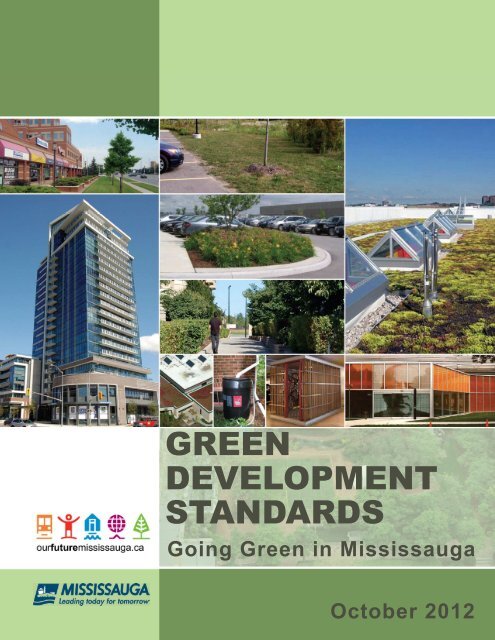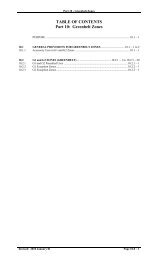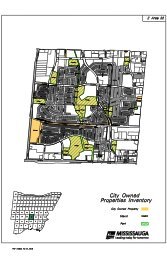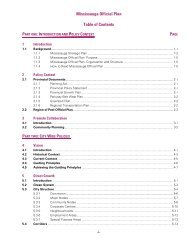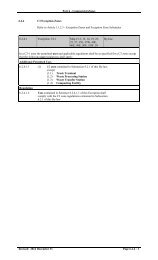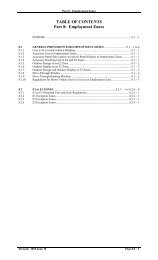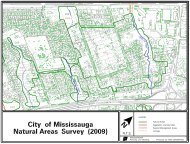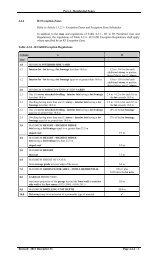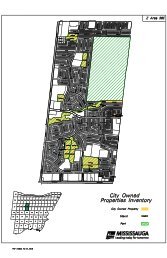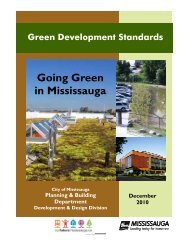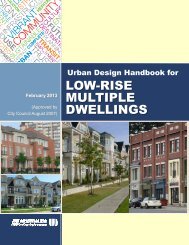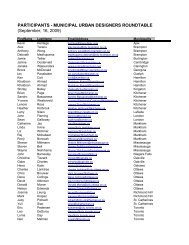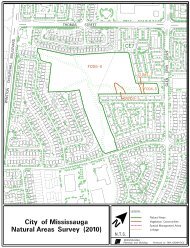GDS-Standards-revised Sept 2012.pub - City of Mississauga
GDS-Standards-revised Sept 2012.pub - City of Mississauga
GDS-Standards-revised Sept 2012.pub - City of Mississauga
You also want an ePaper? Increase the reach of your titles
YUMPU automatically turns print PDFs into web optimized ePapers that Google loves.
GREEN<br />
DEVELOPMENT<br />
STANDARDS<br />
Going Green in <strong>Mississauga</strong><br />
October 2012
Stage One: Green Development <strong>Standards</strong><br />
TABLE OF CONTENTS<br />
In response to <strong>City</strong> Council<br />
direction, this brochure<br />
outlines the Stage One<br />
Green Development<br />
<strong>Standards</strong> that applicants<br />
Preface<br />
1.0 General<br />
2.0 L.I.D. Stormwater Retention<br />
2<br />
3<br />
4<br />
2.1 Bio-Retention<br />
2.2 Rainwater Harvesting<br />
2.3 Permeable Pavement<br />
5<br />
2.4 Grass and Dry Swales<br />
2.5 Green Ro<strong>of</strong>s<br />
3.0 S<strong>of</strong>t Material Landscape<br />
6<br />
7<br />
3.1 New Trees<br />
3.2 Native Vegetation<br />
4.0 Pedestrian and Cycling<br />
Comfort<br />
8<br />
4.1 Pedestrian Walkways<br />
4.2 Pedestrian Comfort<br />
4.3 Bicycle Parking<br />
5.0 Exterior Building Design<br />
10<br />
5.1 Bird Friendly Glazing<br />
5.2 Site and Building Lighting<br />
6.0 LEED-NC Requirements<br />
Links<br />
11<br />
12<br />
The ‘Made in <strong>Mississauga</strong>’ Green Development Strategy<br />
2
October 2012<br />
1.0 PREFACE<br />
will need to consider<br />
when preparing their<br />
site plan and rezoning<br />
applications prior to<br />
development approval.<br />
On July 7, 2010, <strong>City</strong> Council adopted the Green<br />
Development Strategy, which focuses on achieving<br />
sustainability and environmental responsibility in<br />
new development in <strong>Mississauga</strong>. The following<br />
key recommendations are now being<br />
implemented:<br />
• a Green Development Task Force to implement<br />
the "Made in <strong>Mississauga</strong>" Strategy over five<br />
years;<br />
• the third-party green LEED-NC (Leadership in<br />
Energy and Environmental Design for New<br />
Construction) certified Silver rating system as<br />
a guide for development to follow; and<br />
The <strong>City</strong> strongly encourages applicants to<br />
incorporate green sustainable elements into<br />
proposed buildings, site works, construction<br />
methods and long term maintenance programs.<br />
Further to the Stage One Standard requirements,<br />
the <strong>City</strong> also asks that applicants pursue LEED-NC<br />
credits required to achieve Silver certification.<br />
For more information, visit the Canada Green<br />
Building Council for the LEED-NC program,<br />
Sustainable Technologies for the Low Impact<br />
Development Stormwater Management Planning<br />
and Design Guide, and the <strong>City</strong> <strong>of</strong> <strong>Mississauga</strong> for<br />
the Green Development Strategy websites found<br />
on the back <strong>of</strong> this brochure.<br />
• the ‘Made in <strong>Mississauga</strong>’ Stage One Green<br />
Development <strong>Standards</strong>.<br />
Cover Photos<br />
Top left– Hurontario St., east side<br />
Bottom left– North Shore Condo,<br />
Port Credit<br />
Top middle– Swale in Sheridan Park<br />
Second from top middle– Parking<br />
island in industrial area<br />
Third from top middle– Pedestrian<br />
connection, Downtown<br />
Bottom middle– Example <strong>of</strong><br />
sustainable techniques<br />
Top right– Go Bus Terminal,<br />
Streetsville<br />
Bottom right– Example <strong>of</strong> Birdfriendly<br />
screen design<br />
The ‘Made in <strong>Mississauga</strong>’ Green Development Strategy<br />
3
Stage One: Green Development <strong>Standards</strong><br />
2.0 GENERAL<br />
All site plan applications will be required, where<br />
appropriate, to incorporate technologies that<br />
maximize the natural infiltration and retention <strong>of</strong><br />
stormwater through site development.<br />
Throughout this brochure, the commonly known<br />
term, Low Impact Development (LID), is<br />
generally used. However, in some cases, these<br />
technologies have also been referred to as<br />
“Stormwater Best Management Practices”.<br />
For further details on the LID techniques found in<br />
this brochure (including others that have not<br />
been identified, such as downspout disconnection,<br />
soakaways, trenches, vegetated filter strips,<br />
enhanced grass swales and perforated pipe<br />
systems ), see the CVC/TRCA Sustainable<br />
Technologies for the Low Impact Development<br />
Stormwater Management Planning and Design<br />
Guide now available on-line (see link on page<br />
12). Top left — Example <strong>of</strong> grass filter strip before<br />
landscape swales<br />
Middle left — Bio-retention island in parking area<br />
Bottom Left— Pedestrian through-block connection<br />
Bottom Right — Example <strong>of</strong> white ro<strong>of</strong><br />
The ‘Made in <strong>Mississauga</strong>’ Green Development Strategy<br />
4
October 2012<br />
3.0 L.I.D.STORMWATER RETENTION<br />
General<br />
The term “Low Impact Development” is commonly<br />
used to describe the technologies employed to<br />
retain stormwater on site. The <strong>City</strong> <strong>of</strong> <strong>Mississauga</strong><br />
further defines such techniques as “Stormwater<br />
Best Management Practices” that can include<br />
implementation on public lands.<br />
3.1 Bio-Retention<br />
Install a bio-retention system to filter and<br />
temporarily store, treat and infiltrate rainwater<br />
run<strong>of</strong>f (after a large storm event) to control<br />
stormwater quantity and improve its quality prior<br />
to release back into the system.<br />
Top — Typical underground storage tank<br />
Bottom Left — Bio-swales at Riverwood, <strong>Mississauga</strong><br />
Credit River Valley<br />
Bottom Right — Typical rain water barrel<br />
3.2 Rainwater Harvesting<br />
Install rainwater harvesting systems, which<br />
intercept, convey and store rainfall for future use.<br />
The ‘Made in <strong>Mississauga</strong>’ Green Development Strategy<br />
5
Stage One: Green Development <strong>Standards</strong><br />
3.3 Permeable Pavement<br />
Install permeable pavement, as an alternative to<br />
traditional impervious pavement (i.e., asphalt)<br />
with little or no infiltration characteristics, to allow<br />
rainwater to permeate through it and into an<br />
aggregate reservoir. This is ideally suited for areas<br />
with low level traffic such as private roads,<br />
parking lots, walkways, etc. Please note that<br />
“Pervious Stable Surface” may also be used to<br />
identify areas for permeable ‘interlocking’ concrete<br />
paving, pervious concrete or porous asphalt.<br />
Example <strong>of</strong> enhanced<br />
dry grass swale<br />
3.4 Grass and Dry Swales<br />
• Install vegetated and open “grass<br />
swales” (channels) to receive, treat and<br />
attenuate rainwater run<strong>of</strong>f (these are also<br />
known as “enhanced” vegetated swales).<br />
• Promote the use <strong>of</strong> “dry swales” (an enhanced<br />
grass swale that incorporates engineered soil<br />
filter media or growing media) with optional<br />
perforated pipe underdrain or a bio-retention<br />
cell configured as a linear open channel.<br />
Middle — Examples <strong>of</strong> permeable paving set in parking<br />
area and walkway<br />
Below — Example <strong>of</strong> permeable asphalt draining into<br />
bio-swale<br />
The ‘Made in <strong>Mississauga</strong>’ Green Development Strategy<br />
6
October 2012<br />
3.5 Green Ro<strong>of</strong>s<br />
Install green-living ro<strong>of</strong>s consisting <strong>of</strong> a layer <strong>of</strong><br />
growing medium soil with vegetative material on<br />
top <strong>of</strong> a conventional flat or sloped ro<strong>of</strong>, to improve<br />
energy efficiency in buildings, stormwater<br />
absorption and quality, reduce urban heat island<br />
effects, create green space for passive recreation,<br />
and to enhance ro<strong>of</strong> aesthetics. There are two types<br />
<strong>of</strong> green ro<strong>of</strong>s: intensive - providing aesthetic and<br />
environmental value), and extensive - or active<br />
recreational uses:<br />
• Intensive ro<strong>of</strong>s planted with deeply rooted<br />
plants have a deeper soil layer, generally<br />
greater than 15 cm (6 in) <strong>of</strong> growing medium in<br />
depth, to allow for deeply rooted plants, and<br />
• Extensive systems on top <strong>of</strong> ro<strong>of</strong>s consisting <strong>of</strong><br />
thin layers <strong>of</strong> soil with herbaceous vegetative<br />
cover, generally less than 15 cm (6 in) in<br />
depth.<br />
‘Intensive’ Green Ro<strong>of</strong> sits on parking structure at<br />
<strong>Mississauga</strong> Civic Centre<br />
‘Extensive’ Green<br />
Ro<strong>of</strong><br />
Right — Mountain<br />
Equipment Coop -<br />
Toronto<br />
Left — <strong>City</strong> Gate<br />
Condominiums,<br />
<strong>Mississauga</strong><br />
The ‘Made in <strong>Mississauga</strong>’ Green Development Strategy<br />
7
Stage One: Green Development <strong>Standards</strong><br />
4.0 SOFT LANDSCAPE MATERIAL<br />
Plant trees to promote bio-diversity, improve air<br />
quality, reduce the urban heat island effect, and<br />
increase the aesthetic value within the overall<br />
area.<br />
4.2 Native Vegetation<br />
Ensure that a minimum 50% <strong>of</strong> all proposed<br />
plantings are native species, where feasible.<br />
4.1 New Trees<br />
For groups <strong>of</strong> two or more trees planted primarily<br />
in hardscaped areas, provide a minimum volume<br />
<strong>of</strong> 15 m 3 (530 ft 3 ) <strong>of</strong> high quality soil per tree. A<br />
single tree planted in hardscape requires a<br />
minimum volume <strong>of</strong> 30 m 3 (1060 ft 3 ) <strong>of</strong> soil.<br />
• Provide trees planted in s<strong>of</strong>tscape with a<br />
minimum volume <strong>of</strong> 30 m 3 (1,060 ft 3 ) high<br />
quality soil.<br />
• Plant “shade trees” approximately 6-8 m (20-<br />
27 ft) apart along all street frontages, open<br />
space frontages and public walkways.<br />
Bottom Left – New street trees planted in grass<br />
Top Right – Examples <strong>of</strong> landscaped planting in Street<br />
boulevards<br />
Bottom Right – Example <strong>of</strong> grass swale between<br />
parking lot and building<br />
The ‘Made in <strong>Mississauga</strong>’ Green Development Strategy<br />
8
October 2012<br />
5.0 PEDESTRIAN AND CYCLING COMFORT<br />
5.1 Pedestrian Walkways<br />
Design private sidewalks, crosswalks and<br />
walkways to be continuous, universally<br />
accessible, barrier-free and clearly designated.<br />
Connect building entries to pedestrian paths,<br />
transit stops and parking areas for both cars and<br />
bicycles.<br />
5.2 Pedestrian Comfort<br />
• Locate all air exhaust systems and air intake<br />
grates away from pedestrian routes and<br />
amenity areas.<br />
• Provide shade trees along pedestrian<br />
pathways and in amenity spaces to take<br />
advantage <strong>of</strong> summer shade.<br />
Above — Example<br />
<strong>of</strong> bike storage<br />
facility in an<br />
underground<br />
garage<br />
5.3 Bicycle Parking<br />
Locate 50 percent <strong>of</strong> occupant bicycle parking in<br />
a secure weather-protected area contained within<br />
the development site.<br />
Top — Example<br />
<strong>of</strong> vertical<br />
parking grate<br />
screened by<br />
landscape<br />
Middle — Walkway<br />
in green space<br />
Bottom —<br />
Example <strong>of</strong><br />
landscape planting<br />
surrounding<br />
parking ventilation<br />
The ‘Made in <strong>Mississauga</strong>’ Green Development Strategy<br />
9
Stage One: Green Development <strong>Standards</strong><br />
6.0 EXTERIOR BUILDING DESIGN<br />
6.1 Bird Friendly Glazing<br />
• Treat glass on buildings with a density<br />
pattern between 10-28 cm (4 to 11 in) apart<br />
for a minimum <strong>of</strong> the first 10 to 12 m (33-40<br />
ft) above grade,<br />
OR<br />
• Mute reflections for a minimum <strong>of</strong> the first<br />
10-12 m (33-40 ft) portion <strong>of</strong> a building<br />
above grade. Where a green ro<strong>of</strong> is<br />
constructed adjacent to glass surfaces,<br />
ensure that the glass is treated to a height <strong>of</strong><br />
at least 12 m (40 ft) above the level <strong>of</strong> the<br />
green ro<strong>of</strong>, to prevent potentially fatal<br />
collisions with windows.<br />
• Where exhaust/ventilation grates cannot be<br />
avoided at ground level, design the grates to<br />
have a porosity <strong>of</strong> less than 2 cm x 2 cm<br />
(1in x 1in).<br />
6.2 Site and Building Lighting<br />
• Install exterior light fixtures that are<br />
properly shielded to prevent glare and/or<br />
light to trespass onto any neighbouring<br />
properties.<br />
• Avoid up-lighting from exterior light fixtures<br />
mounted on buildings unless they are<br />
designated as an integral component <strong>of</strong> a<br />
heritage structure.<br />
Example <strong>of</strong> bird friendly glazing in the<br />
<strong>City</strong><br />
Below – LED lighting along street, New York <strong>City</strong><br />
Above – Green ro<strong>of</strong> on <strong>City</strong> Hall Building, Chicago, IL<br />
The ‘Made in <strong>Mississauga</strong>’ Green Development Strategy<br />
10
October 2012<br />
7.0 LEED-NC REQUIREMENTS<br />
The <strong>City</strong> <strong>of</strong> <strong>Mississauga</strong> promotes sustainability<br />
when planning for new development, and now<br />
requests that development applicants achieve LEED<br />
silver certification for ‘New Construction’. The LEED<br />
(Leadership in Energy and Environmental Design)<br />
Green Building Rating System encourages<br />
sustainable green building and development<br />
practices through the creation and implementation<br />
<strong>of</strong> universally understood tools and performance<br />
criteria. The Canadian LEED system is tailored<br />
specifically for Canadian climates, construction<br />
practices and regulations.<br />
Silver certification is achieved by scoring 50-59<br />
credits (<strong>of</strong> a possible 100 base credits, six<br />
innovative design and 4 regional priority points)<br />
which is assessed by a LEED accredited third<br />
party. With four possible levels <strong>of</strong> certification<br />
(certified, silver, gold and platinum), LEED is<br />
flexible enough to accommodate a wide range <strong>of</strong><br />
green building strategies that best fit the context<br />
<strong>of</strong> a particular site and/or project.<br />
LEED is an internationally accepted third-party<br />
certification program and benchmark for the design,<br />
construction and operation <strong>of</strong> high performance<br />
green buildings. LEED provides building owners and<br />
operators with the tools they need to have an<br />
immediate impact on their buildings’ performance.<br />
It promotes a holistic approach to sustainability by<br />
considering performance in sustainable site<br />
development, water efficiency, energy efficiency,<br />
materials selection, and indoor environmental<br />
quality regarding human and environmental health.<br />
Bottom Left —<br />
Hazel McCallion<br />
Academic Learning<br />
Centre University<br />
Toronto <strong>Mississauga</strong><br />
— LEED silver<br />
certified<br />
Right — North<br />
Shore Condo —<br />
Planning for LEED<br />
Top —Redcliff<br />
Realty Advisors<br />
Inc. — LEED-NC<br />
The ‘Made in <strong>Mississauga</strong>’ Green Development Strategy<br />
11
Stage One: Green Development <strong>Standards</strong><br />
LINKS<br />
See LEED-NC (Leadership in Energy and Environmental Design-New Construction):<br />
http://www.cagbc.org/Content/NavigationMenu/Programs/LEED/RatingSystems/NewConstruction/<br />
default.htm<br />
See Credit Valley/Toronto Regional Conservation Authority–Low Impact Development Stormwater<br />
Management Planning and Design Guide:<br />
www.sustainabletechnologies.ca/portal/aliasRainbow/langen/tabID578/DesktopDefault.aspx<br />
See <strong>City</strong> <strong>of</strong> <strong>Mississauga</strong> Green Development Strategy on both the Living Green and Planning & Building<br />
homepages (links below):<br />
www.mississauga.ca/portal/discover/ourfuturegreen<br />
or<br />
www.mississauga.ca/portal/residents/planningandbuilding<br />
The ‘Made in <strong>Mississauga</strong>’ Green Development Strategy<br />
12
October 2012<br />
The Living Green Wall is a <strong>City</strong><br />
<strong>of</strong> <strong>Mississauga</strong> initiative that<br />
incorporates innovative<br />
technologies and provides<br />
environmental benefits.<br />
For more information:<br />
<strong>City</strong> <strong>of</strong> <strong>Mississauga</strong><br />
Planning & Building Dept.<br />
Development & Design Division<br />
Urban Design<br />
Attention:<br />
Green Development<br />
Project Leader<br />
905-615-4311<br />
urban.design@mississauga.ca<br />
The new <strong>Mississauga</strong> Official Plan<br />
supports the Green Development<br />
Strategy and the recommended<br />
The ‘Made in <strong>Mississauga</strong>’ Green Development Strategy<br />
13
<strong>City</strong> <strong>of</strong> <strong>Mississauga</strong><br />
Planning and Building Department, Development and Design Division<br />
300 <strong>City</strong> Centre Drive, 6th Floor, <strong>Mississauga</strong> ON, L6B 3C1 — Tel: 905-896-5511 Fax: 905-896-5553<br />
w w w . m i s s i s s a u g a . c a


